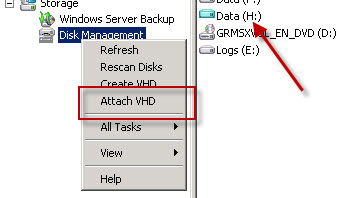In my article on backup error event id 2137 and what it means for Exchange 2010 a reader asked whether backups of Exchange 2010 DAG members include both the active and passive database copies.
Update: according to Microsoft, “All database copies can be backed up using an Exchange-aware, Volume Shadow Copy Service (VSS)-based backup application. However, the built-in support for Windows Server Backup is for active copies only. You can’t use Windows Server Backup to back up passive copies.” The rest of the article below has been left unedited, however be aware that the example demonstrated is of an unsupported scenario
The short answer is yes, however there are some important considerations to be aware of. From Microsoft TechNet:
Passive mailbox database copies are backed up using a separate VSS writer in the Microsoft Exchange Replication service. The Microsoft Exchange Replication service VSS Writer doesn’t support restores. Although you can back up a passive mailbox database copy using Microsoft System Center Data Protection Manager or a third-party Exchange-aware VSS-based application, you can’t perform a VSS restore directly to a passive mailbox database copy. However, you can perform a VSS restore to an alternate location, suspend replication to the passive copy, and then copy the database and log files from the alternate location to the location of the passive database copy in the file system.
To demonstrate this, here you can see the mailbox databases MB-HO-* that are currently active on server HO-EX2010-MB2. They have no LastFullBackup timestamp because they have never been backed up.
[PS] C:\>Get-MailboxDatabase -status | ft name,mounted*,lastfull* -auto Name MountedOnServer Mounted LastFullBackup ---- --------------- ------- -------------- MB-HO-01 HO-EX2010-MB2.exchangeserverpro.net True MB-HO-02 HO-EX2010-MB2.exchangeserverpro.net True MB-HO-03 HO-EX2010-MB2.exchangeserverpro.net True MB-BR-01 BR-EX2010-MB.exchangeserverpro.net True
On server HO-EX2010-MB1 I ran a mailbox server backup using Windows Server Backup.

After the backup completed the following can be seen. First, the LastFullBackup time stamp has not been written.
[PS] C:\>Get-MailboxDatabase -status | ft name,mounted*,lastfull* -auto Name MountedOnServer Mounted LastFullBackup ---- --------------- ------- -------------- MB-HO-02 HO-EX2010-MB2.exchangeserverpro.net True MB-HO-01 HO-EX2010-MB2.exchangeserverpro.net True MB-HO-03 HO-EX2010-MB2.exchangeserverpro.net True
Next, the disk that the backups were written to contain VHD files matching the size of the data stored on the backed up volumes. For example, the F: (Data) drive holds about 2Gb of data, and the VHD for that volume is about the same size.
 Because we can mount the VHD as a disk on the server we have the opportunity to inspect the contents inside of it.
Because we can mount the VHD as a disk on the server we have the opportunity to inspect the contents inside of it.
 We can see that even though it was not the active databases at the time of the backup, the EDB file for database MB-HO-01 (and others) was still backed up by the server.
We can see that even though it was not the active databases at the time of the backup, the EDB file for database MB-HO-01 (and others) was still backed up by the server.
[PS] C:\>Get-ChildItem H: -Recurse | where {$_.name -like "*.edb"} | select name
Name
----
HO-PF-01.edb
MB-HO-01.edb
MB-HO-02.edb
MB-HO-03.edb
PF-HO-01.edb
Next I’ll run another backup of HO-EX2010-MB1, but this time the mailbox database MB-HO-01 has been made active on HO-EX2010-MB1.
This time the LastFullBackup time stamp is written to the database.
[PS] C:\>Get-MailboxDatabase -status | ft name,mounted*,lastfull* -auto Name MountedOnServer Mounted LastFullBackup ---- --------------- ------- -------------- MB-HO-01 HO-EX2010-MB1.exchangeserverpro.net True 11/6/2011 1:40:19 PM MB-HO-02 HO-EX2010-MB2.exchangeserverpro.net True MB-HO-03 HO-EX2010-MB2.exchangeserverpro.net True MB-BR-01 BR-EX2010-MB.exchangeserverpro.net True
So what do we learn from this?
Reminder, the below should be read in conjunction with the notice at the start of the article, as backing up passive database copies using Windows Server Backup is not a supported scenario
- Yes, passive database copies stored on a volume are backed up by Windows Server Backup
- Yes, this allows backups of passive database copies to be restored, although not directly
- Yes, this would allow a backup of a passive database copy to be used for disaster recovery of a database
- No, the backup time stamp is not written when a passive database copy is backed up, so any monitoring of backups that involves checking that time stamp needs to take that into consideration



Pingback: baercomputing.com
which is the best back-up and restoring strategy for 2010 exchange
which is the best back and restoring strategy for 2010 exchange
Hi Paul,
has this changed under Exchange 2013?
Thanks,
Marcel
Unclear. It appears to be supported to backup passive DB copies with Windows Server Backup due to changes in the VSS writer for Exchange 2013. However I don’t see a clear statement on support for restoring passive database copies.
http://technet.microsoft.com/en-us/library/dd876874(v=exchg.150).aspx
means, best practice is backing up the active copy only?
For Windows Server Backup at least that is the assumption I would stick with for now.
Nice one Paul, Everything is clear. Thank you.
Thanks, This is very helpful.
I’m a little confused. If we do this (backup a passive copy), how do we ensure that the active copy and remaining passive copies will have their logs truncated? Seems backwards to me.
Any advice would be great.
You would back up the active database copy to ensure proper database backup and t-log truncation occurs. That will trigger log truncation for passive copies as well.
Pingback: T. Luppold Engineer Talk – Automate Rebalancing a Database Availability Group
Pingback: Automate Rebalancing a Database Availability Group | Insiko – WebBlog